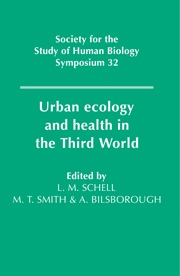Book contents
- Frontmatter
- Contents
- List of contributors
- Acknowledgements
- 1 Human biological approaches to the study of Third World urbanism
- 2 Social and cultural influences in the risk of cardiovascular disease in urban Brazil
- 3 The urban disadvantage in the developing world and the physical and mental growth of children
- 4 Differences in endocrine status associated with urban-rural patterns of growth and maturation in Bundi (Gende-speaking) adolescents of Papua New Guinea
- 5 Nutritionally vulnerable households in the urban slum economy: a case study from Khulna, Bangladesh
- 6 Urban-rural differences in growth and diarrhoeal morbidity of Filipino infants
- 7 Child health and growth in urban South Africa
- 8 From countryside to town in Morocco: ecology, culture and public health
- 9 Urban-rural population research: a town like Alice
- 10 Selection for rural-to-urban migrants in Guatemala
- 11 Health and nutrition in Mixtec Indians: factors influencing the decision to migrate to urban centres
- 12 Urban health and ecology in Bunia, N.E. Zaire, with special reference to the physical development of children
- 13 Food for thought: meeting a basic need for low-income urban residents
- 14 Immunological parameters in northeast Arnhem Land Aborigines: consequences of changing settlement patterns and lifestyles
- 15 Amerindians and the price of modernisation
- 16 Sex ratio determinants in Indian populations: studies at national, state and district levels
- 17 Polarisation and depolarisation in Africa
- 18 Urbanisation in the Third World: health policy implications
- Index
12 - Urban health and ecology in Bunia, N.E. Zaire, with special reference to the physical development of children
Published online by Cambridge University Press: 26 December 2009
- Frontmatter
- Contents
- List of contributors
- Acknowledgements
- 1 Human biological approaches to the study of Third World urbanism
- 2 Social and cultural influences in the risk of cardiovascular disease in urban Brazil
- 3 The urban disadvantage in the developing world and the physical and mental growth of children
- 4 Differences in endocrine status associated with urban-rural patterns of growth and maturation in Bundi (Gende-speaking) adolescents of Papua New Guinea
- 5 Nutritionally vulnerable households in the urban slum economy: a case study from Khulna, Bangladesh
- 6 Urban-rural differences in growth and diarrhoeal morbidity of Filipino infants
- 7 Child health and growth in urban South Africa
- 8 From countryside to town in Morocco: ecology, culture and public health
- 9 Urban-rural population research: a town like Alice
- 10 Selection for rural-to-urban migrants in Guatemala
- 11 Health and nutrition in Mixtec Indians: factors influencing the decision to migrate to urban centres
- 12 Urban health and ecology in Bunia, N.E. Zaire, with special reference to the physical development of children
- 13 Food for thought: meeting a basic need for low-income urban residents
- 14 Immunological parameters in northeast Arnhem Land Aborigines: consequences of changing settlement patterns and lifestyles
- 15 Amerindians and the price of modernisation
- 16 Sex ratio determinants in Indian populations: studies at national, state and district levels
- 17 Polarisation and depolarisation in Africa
- 18 Urbanisation in the Third World: health policy implications
- Index
Summary
Introduction
Bunia is the chief town of the Ituri region, part of the Northeast Zone of Zaïire, situated at 1°35′ N and 30°15′ E, at an altitude of 1250m on a hilly, fertile plateau. It has a humid, tropical climate, warmest in April–May and more temperate in July–August. Average humidity is 87%, with a rainfall all through the year of between 1200 and 1400 mm, heaviest in August–September, and drier in December–January. Originally a forest area, it was gradually transformed by slash-and-burn into short grassland. At present, sweet potatoes, cassava, beans and various vegetables and fruits are grown, which make up the main staple foods of the area. The herding Hema provide beef; goat, sheep and pig meat are also consumed. Fresh and smoked fish come mainly from nearby Lake Mobutu (formerly Albert Lake), where fish are abundant and local and industrial fishing is practised. Lately, more meat and fish has been shipped by road to the cities of Kisangani, Beni and Goma, and flown to Kinshasa. These exports, together with gold-panning in the area, have driven up prices, and many town people deriving their main income from wages have a hard time coping with inflation.
The original inhabitants of the region were Lendu farmers and Hema herders. They are now a minority among later immigrants, who come from three distinct ethnolinguistic groups: Bantu (Bira, Nande and others) from the south, Sudanese (Lugbara, Lendu, Ngiti and Lese) from the northwest, and Nilotics (Hema, Alur) from the northeast (see Vansina, 1965.)
- Type
- Chapter
- Information
- Urban Ecology and Health in the Third World , pp. 172 - 192Publisher: Cambridge University PressPrint publication year: 1993



